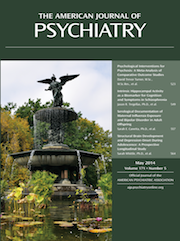In 1913, 30-year-old German psychiatrist Karl Jaspers published the first edition of
General Psychopathology, in which he summarized current psychiatric knowledge and included his ideas regarding the methodological and scientific issues then facing psychiatry. In the words of his biographer, Jaspers thought the discipline of psychiatry “was crying out for a systematic clarification of current thinking” and that “to make real progress psychiatrists must learn to think,” but his book was not well received by more senior German psychiatrists (
1). Jaspers subsequently became better known as a philosopher (
1). In 1922, when writing the third edition (
2), Jaspers was no longer in direct contact with psychiatry and asked for suggestions from Kurt Schneider, an excellent young psychiatrist, who then probably updated the later editions of the book.
The first English translation of
General Psychopathology, more than 900 pages long, was published in 1963, reflecting the seventh German edition (
3). Jaspers’ book defined psychiatry as a hybrid scientific discipline that must combine the methods of the natural and the social sciences which, respectively, provide an explanation of psychiatric diseases that follows the medical model and an understanding of psychiatric abnormalities that are variations of human living.
General Psychopathology has had a continuous influence on psychiatry in the United Kingdom, including psychiatric research (
4) and resident training (
5–
7), but has had very limited direct impact on U.S. psychiatry.
General Psychopathology’s English translator (
8) described a visit to a Philadelphia psychiatry department, where the chairman told him, “Nobody reads it, but it is obligatory to have it seen on your shelf.” The
American Journal of Psychiatry has published only two articles on Jaspers. In 1967, Havens (
9) commented on the publication of the
General Psychopathology translation and hoped that U.S. psychiatrists would be open to Jaspers, who “provides a systematic rationale for eclecticism.” In 1986, Schwartz and Wiggins (
10) used Jaspers’ “explaining” and “understanding” concepts in the context of Engel’s biopsychosocial model.
At 100 years, we might speculate on what Jaspers would think about the current differences in diagnostic strategy between the National Institute of Mental Health’s Research Domain Criteria (RDoC) (
11) and DSM-5. The RDoC appears reminiscent of Karl Wernicke’s attempt to consider all mental disorders as brain disorders, and DSM-5 follows Emil Kraepelin’s dictum that all psychiatric disorders follow the medical model of disease. Jaspers had strong critiques of both Wernicke and Kraepelin.
Wernicke and RDoC
According to Insel et al. (
11), “the RDoC framework conceptualizes mental illness as brain disorders. In contrast to neurological disorders with identifiable lesions, mental disorders can be addressed as disorders of brain circuits.” At the beginning of the 20th century, Wernicke, already famous for describing the sensory speech center, also wrote a textbook including a pathophysiological model of the relationship between brain and behavior, which became one of the most important competitors of Kraepelin’s textbook (
12,
13). According to Jaspers, Wernicke believed that all mental illnesses are “cerebral illnesses in the sense that they can be wholly comprehended in terms of cerebral processes” (
3). If Wernicke had not died young, we psychiatrists might be living in a “Wernickian world” instead of a “Kraepelinian world” (
13). Although Jaspers acknowledges that Wernicke’s pathophysiological model applied well to aphasia and other neurological disorders, Jaspers thought Wernicke erred in extending it to all psychiatric disorders. Jaspers contrasted Wernicke and Sigmund Freud, who were both disciples of the same Viennese mentor, Theodor Meynert, saying that they were positioned at opposite extremes in psychiatry (
3). In Jaspers’ view, Wernicke thought that “explaining” was the only methodology needed in psychiatry. On the other hand, Freud thought that “understanding” was the only methodology needed in psychiatry. The RDoC’s focus on brain disorders implies a view similar to Wernicke’s that explaining is the only methodology needed in psychiatry.
Kraepelin and DSM-5
The diagnostic scheme for psychiatric disorders developed by the Department of Psychiatry at Washington University (
14), which led to DSM-III, DSM-IV, and DSM-5, is a Kraepelinian nosological model where mental disorders follow the medical model of disease as a set of identifiable symptoms. Jaspers was critical of Kraepelin’s idealization of the medical model of general paralysis of the insane (neurosyphilis) as a model for psychiatric disorders, with each disorder having a unique cause, set of symptoms, course, outcome, and neuropathology. In
General Psychopathology, Jaspers proposed that some psychiatric disorders follow the traditional medical model, principally those that were called organic mental disorders in DSM-III. Jaspers called them “known somatic illnesses with psychic disturbances” (“Group I”). Other psychiatric disorders, he proposed, were not medical disorders but variations of normality; Jaspers called these disorders of personality, including “abnormal reactions, neurosis and neurotic syndromes, as well as abnormal personalities and their developments” (“Group III”). Situated between them were the psychoses (“Group II”), which, according to Jaspers, could be distinguished from normality but were not clearly separated from each other—e.g., intermediate cases between schizophrenia and manic-depressive illnesses. Jaspers felt that Kraepelin’s denial of the heterogeneous nature of mental disorders failed to capture some psychiatric disorders correctly (
3).

